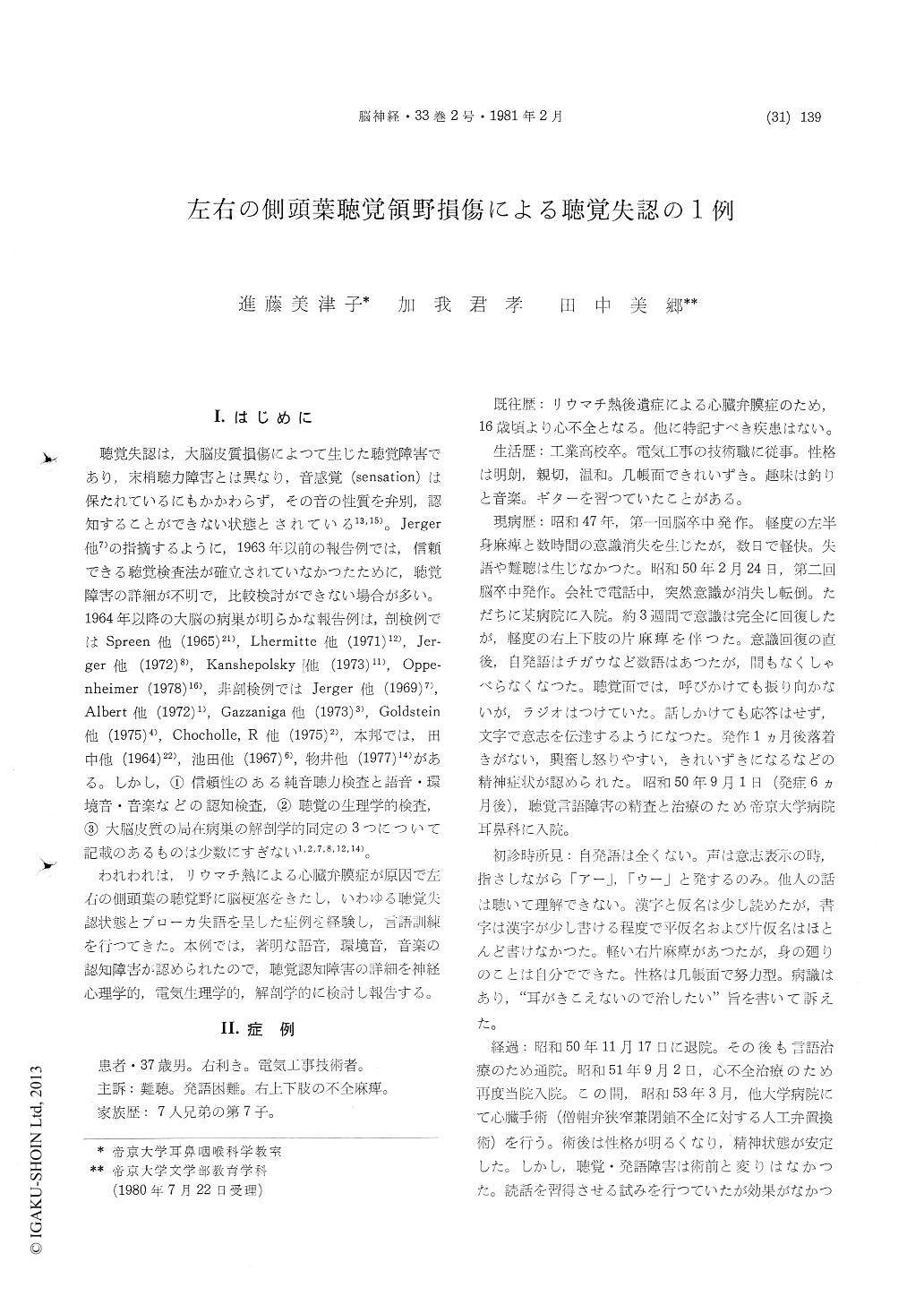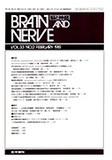Japanese
English
- 有料閲覧
- Abstract 文献概要
- 1ページ目 Look Inside
I.はじめに
聴覚失認は,大脳皮質損傷によつて生じた聴覚障害であり,末梢聴力障害とは異なり,音感覚(sensation)は保たれているにもかかわらず,その音の性質を弁別,認知することができない状態とされている13,15)。Jerger他7)の指摘するように,1963年以前の報告例では,信頼できる聴覚検査法が確立されていなかつたために,聴覚障害の詳細が不明で,比較検討ができない場合が多い。1964年以降の大脳の病巣が明らかな報告例は,剖検例ではSpreen他(1965)21),Lhermitte他(1971)12),Jer—ger他(1972)8),Kanshepolsky他(1973)11),Oppe—nheimer (1978)16),非剖検例ではJerger他(1969)7),Albert他(1972)1),Gazzaniga他(1973)3),Goldstein他(1975)4),Chocholle,R他(1975)2),本邦では,田中他(1964)22),池田他(1967)6),物井他(1977)14)がある。しかし,①信頼性のある純音聴力検査と語音・環境音・音楽などの認知検査,②聴覚の生理学的検査,③大脳皮質の局在病巣の解剖学的同定の3つについて記載のあるものは少数にすぎない1,2,7,8,12,14)。
われわれは,リウマチ熱による心臓弁膜症が原因で左右の側頭葉の聴覚野に脳梗塞をきたし,いわゆる聴覚失認状態とブローカ失語を呈した症例を経験し,言語訓練を行つてきた。本例では,著明な語音,環境音,音楽の認知障害か認められたので,聴覚認知障害の詳細を神経心理学的,電気生理学的,解剖学的に検討し報告する。
This case of auditory agnosia was first diagnosed in 1975 when a 37 year old man was admitted to Teikyo Univ. hospital following a cerebral vascular accident. The results of a comprehensive follow-up examination conducted 5 years later are reported here.
Since the age of 16, he had suffered from cardiac failure with mitral stenosis, which was caused by rheumatic fever in infancy. He had no history of any ear problems or hearing problems. After he graduated an industrial high school, he worked as an electrician in the construction industry. He was mild in character and regular in his habits. Past times included fishing and playing guitar.
In 1972 the patient experienced loss of conscious-ness of several hours duration and left hemiparesis. This was diagnosed as resulting from an embolic cerebral infarction, and the symptoms cleared with-out residua.
In February 1975, he again suddenly became un-conscious and fell while talking over the telephone in his office. On admission he had normal vital signs and was alert but could utter only a few unintel-ligible sounds. He had a mild right hemiparesis with no facial weakness, a right inferior temporal hemianopia and a Babinski sign on the right.
A clinical speech and hearing evaluation on ad-mission demonstrated that he could follow no spok-en commands, but comprehended written commands and gestures. He made no meaningful sounds. Fre-quently he turned his face toward sounds such as human's voice, baby's cry, foot steps and others. He appeared frustrated by his difficulty in communi-cating. The impression was"severe mixed aphasia".
The clinical diagnosis was embolic infarction in the left hemisphere. Examinations by CT scan, auditory evoked responses, and speech and hearing tests were repeated to evaluate the patient.
1) CT scans in 1975 and 1980 demonstrated low-density areas in the bilateral superior temporal gyrus and in the left inferior parietal lobe. The posterior fossa showed no lesions. 2) Auditory brain stem responses of both ears had normal configurations at 85 dB SL and normal threshold of 15 dB SL. Pa of the middle latency component and N1, P2, and N2 of slow vertex responses were absent in both ars. These results ruled out lesions in cochlea and brain stem. 3) Speech and language evaluation showed himto be mute but able to communicate inshort, telegraphic, written sentences containing some spelling and aphasic errors. The neuropsych-ological diagnosis was motor aphasia anditory agn-osia. Almost normal intelligence was disclosed by a Japanese version of the WAIS. 4) The findings of conventional audiometry and special tests for auditory perception were:
a) Pure tone audiometry revealed a moderate hearing loss on the right and a mild hearing loss on the left, but the threshoulds were not always stable. b) Bekesy audiometry of both ears showed a tone decay. c) Speech audiometry of both ears showed a tone decay. c) Speech audiometry of both ears revealed that the patient was unable to dis-criminate any monosyllabic words and digit num-bers (speech intelligibility score was 0%). Auditory perception of speech in this patient was completely impaired. d) Music perception tests showed that he could distinguish neither two different rhythms nor melodies. Although he could not identify even familiar melodies he did feel emotion of quality of music, for example,"pleasant"and"sad". e) He could not recognize the prosodic features of spoken sentences and melodies. f) His perceptive ability of environmental sounds (including the sound of musical instruments) was not impaired. g) Both intensity difference limen and frequency difference limen were impaired, especially for the right ear.
The clinical opinion was that he had continued severe cortical auditory imperception but was not deaf. He also had motor aphasia, with only mod-erate problems in reading and writing, unchanged from 1975. The audiometric findings suggested im-provement in recognition of the presence of envi-ronment sound and of the emotion of aspects of music but no improvement in recognition of speech sounds and music.

Copyright © 1981, Igaku-Shoin Ltd. All rights reserved.


